May 13, 2019 feature
Researchers present new direct-detection constraints on Sub-GeV dark matter
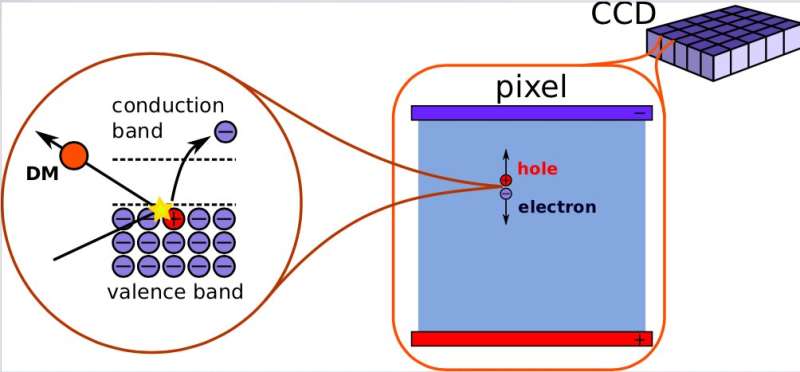
In a recent study, a team of researchers has presented new direct-detection constraints on eV-to-GeV dark matter interacting with electrons, using a new prototype detector developed as part of the Sub-Electron-Noise Skipper-CCD Experimental Instrument (SENSEI) project. The SENSEI collaboration is comprised of researchers from several institutions, including the Fermi National Accelerator Laboratory (Fermilab), the Lawrence Berkeley National Laboratory (Berkeley Lab), Stony Brook University, Tel Aviv University and the University of Oregon.
"SENSEI's goal is to search for dark matter in the mass range 1 eV to 1 GeV, i.e. many orders of magnitude in mass below the proton," Rouven Essig, one of the researchers who carried out the study and a faculty member at Stony Brook University, told Phys.org. "This can be done by searching for dark matter interactions with electrons. However, performing such a search requires ultra-sensitive detectors, since when dark matter scatters off an electron, it produces only a tiny amount of charge in a detector. SENSEI uses Charge Coupled Devices (CCDs) that have an ultra-low readout noise, so-called Skipper-CCDs."
The Skipper-CCDs used by SENSEI were developed as part of an R&D collaboration between Fermilab and Berkeley Lab. In previous studies, the readout noise was a limiting factor, as it restricted the accuracy with which the charge in the CCDs could be measured. The use of new sensors now allows researchers to attain a precise measurement of this charge, which in turn enables a search for dark matter interactions with electrons at unprecedented levels.
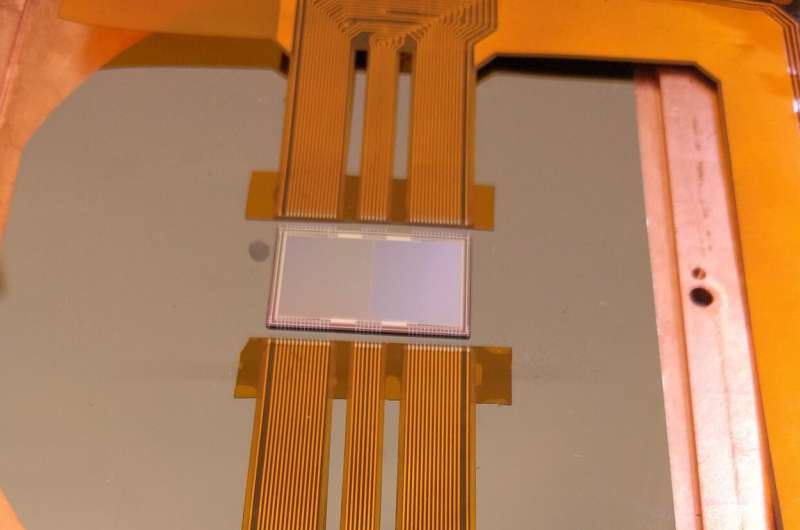
In their study, the SENSEI Collaboration collected data in the MINOS Hall, a 120-foot-long cavern located 350 feet below the surface of the Fermilab campus. The MINOS cavern contains a smaller version of the MINOS detector in Soudan, which is used to measure the properties of neutrinos.
"We took several sets of data with a small, 0.1 gram, prototype Skipper-CCD at the underground MINOS facility at Fermilab," explained Juan Estrada, a scientist at Fermilab who was involved in the study. "This prototype was packaged and shielded in a copper vessel."
The researchers carried out a series of experiments. Firstly, they read out the Skipper CCD continuously accumulating an exposure of 0.177g/day. Although they observed no events involving three or more electrons, they found a large one- and two- electron background event rate. They attributed this finding to spurious events induced by the amplifier in the Skipper-CCD readout stage.
-
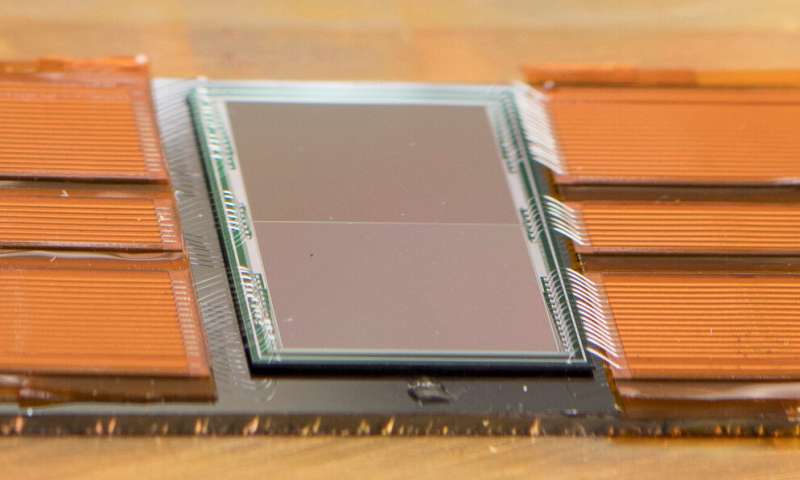
The prototype Skipper-CCD used by the researchers. Credit: Abramoff et al. -
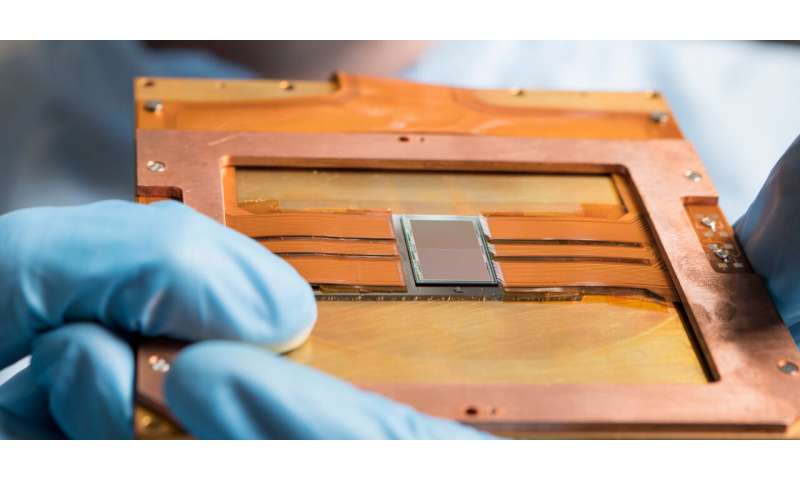
The prototype Skipper-CCD used by the researchers. Credit: Abramoff et al.
The SENSEI Collaboration also tested a second strategy, which involved taking five sets of data while switching off all amplifiers and exposing the Skipper CCD for 120ks. Subsequently, the researchers read out the data via the best prototype amplifier available to them. In this case, they observed a one-electron event rate that was almost 2 orders of magnitude lower than the event rate observed in their continuous-readout experiment. Once again, they observed no events containing three or more electrons, for an exposure of 0.069g/day.
"Our data was able to set new constraints on dark matter, including the best constraints on dark matter scattering of electrons for masses in the range 500 keV to 5 MeV," said Tien-Tien Yu, a faculty member at the University of Oregon who carried out the study. "This data was taken with a prototype detector. One of our main goals was to improve our understanding of the behavior of the detector so that we are ready to collect data with improved sensors in the future."
The SENSEI Collaboration used the data collected in their study to derive world-leading constraints on dark matter-electron scattering (for masses between 500keV and 5MeV), as well as on dark-photon dark matter that is being absorbed by electrons (for a range of masses below 12.4 eV). These results could enhance their understanding of detectors and ultimately inform data collection using more advanced sensors.
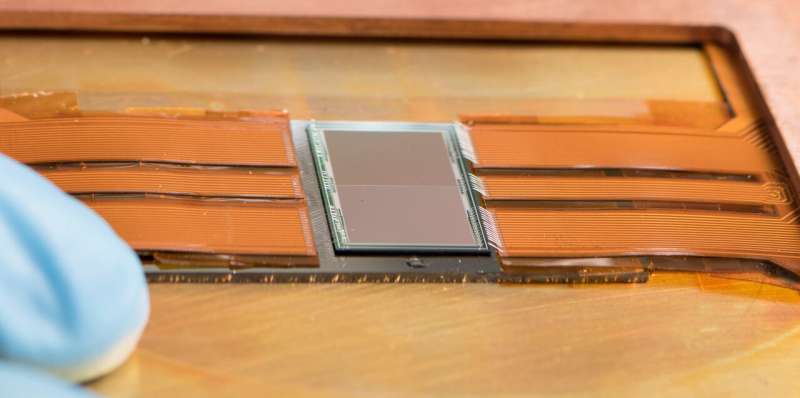
"We are now procuring new, improved Skipper-CCDs, with which we will build a much larger detector," said Javier Tiffenberg, a scientist at Fermilab who was involved in the study. "After testing the new sensors, we will take new data at Fermilab as well as at SNOLAB (Canada) to search for dark matter."
Currently, the SENSEI collaboration is procuring approximately 100g of new Skipper-CCDs and customized electronics for an experiment at SNOLAB, which are set to be installed later this year. According to the researchers' predictions, these sensors should significantly outperform current ones, with an improved noise performance and a lower dark-count rate.
Tomer Volansky, a faculty member at Tel Aviv University who is part of the SENSEI collaboration, stated: "The resulting search will probe orders of magnitude of new dark matter parameter space. We are very excited about what lies ahead."
More information: Orr Abramoff et al. SENSEI: Direct-Detection Constraints on Sub-GeV Dark Matter from a Shallow Underground Run Using a Prototype Skipper CCD, Physical Review Letters (2019). DOI: 10.1103/PhysRevLett.122.161801
Journal information: Physical Review Letters
© 2019 Science X Network





















